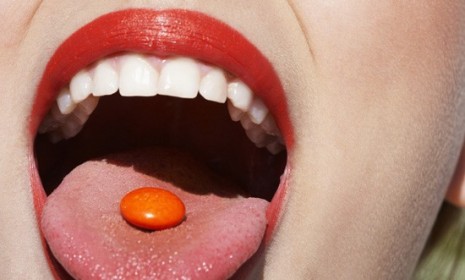Sunscreen ... in a pill?
Scientists believe they may be on the cusp of developing a pill that would prevent sunburn

A type of coral found in Australia's Great Barrier Reef might someday be used to create sunscreen — in a pill. The coral has a unique way of generating its own protection from the sun's damaging UV radiation, which can cause painful sunburns and is a primary cause of skin cancer. If scientists can figure out how to put the coral's natural sunscreen into pill form, this pill might not only eliminate the need for greasy sunblock lotions but also prevent eye damage caused by UV rays. Here, a brief guide:
Why does coral need sunscreen?
Corals live in shallow water in the tropics, where UV radiation is very intense. The animals living there must have some way of preventing skin damage from being in the sun all day, every day. Scientists never understood how these animals protected themselves from the sun until they discovered the secret hidden inside the coral.
The Week
Escape your echo chamber. Get the facts behind the news, plus analysis from multiple perspectives.

Sign up for The Week's Free Newsletters
From our morning news briefing to a weekly Good News Newsletter, get the best of The Week delivered directly to your inbox.
From our morning news briefing to a weekly Good News Newsletter, get the best of The Week delivered directly to your inbox.
How does coral defend itself from UV damage?
Algae. The coral, Acropora microphthalma, has a unique symbiotic relationship with a type of algae that lives inside it. The algae creates a chemical that it shares with the coral, and the coral then modifies it into a sunscreen. In return, the algae benefits by having shelter inside the coral, as well as by using the coral's waste for photosynthesis.
Is coral the only animal that benefits from its sunscreen?
No. Small fish that feed on the coral — and larger fish that eat the small fish — also carry the same sunblock protection. "It is clearly passed up the food chain," says researcher Dr. Paul Long of King's College, London, as quoted in Mother Nature Network. Long believes that if his team of scientists can develop a synthetic form of this chemical, they will be able to "create a sunscreen for human use, perhaps in the form of a tablet, which would work in a similar way."
A free daily email with the biggest news stories of the day – and the best features from TheWeek.com
When will this pill be available?
"Don't toss your high-SPF lotions and creams yet," says Jane E. Allen of ABC News. Acropora microphthalma is endangered, so scientists need to create a synthetic form of the compound in the laboratory. If all goes according to plan, Long hopes to accomplish that, and begin testing in about two years, and then bring a pill to market in roughly five years.
Sources: ABC News, King's College, Mother Nature Network, Telegraph

